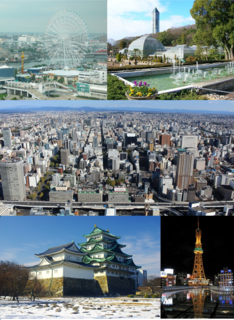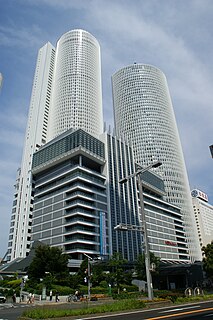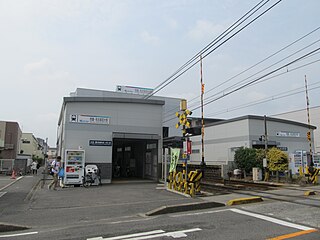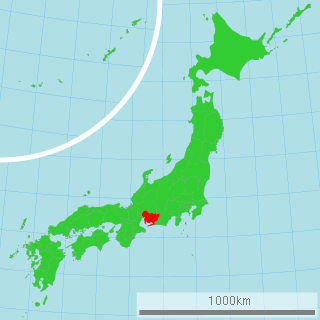
Nagoya (名古屋) is the largest city in the Chūbu region of Japan. It is Japan's fourth-largest incorporated city and the third-most-populous urban area. It is located on the Pacific coast on central Honshu. It is the capital of Aichi Prefecture and is one of Japan's major ports along with those of Tokyo, Osaka, Kobe, Yokohama, Chiba, and Kitakyushu. It is also the center of Japan's third-largest metropolitan region, known as the Chūkyō metropolitan area. As of 2015, 2.28 million people lived in the city, part of Chūkyō Metropolitan Area's 10.11 million people. It is also one of the 50 largest urban areas in the world.
The Japanese addressing system is used to identify a specific location in Japan. When written in Japanese characters, addresses start with the largest geographical entity and proceed to the most specific one. When written in Latin characters, addresses follow the convention used by most Western addresses and start with the smallest geographic entity and proceed to the largest. The Japanese system is complex and idiosyncratic, the product of the natural growth of urban areas, as opposed to the systems used in cities that are laid out as grids and divided into quadrants or districts.

Marukawa Confectionery Co., Ltd. is a Japanese manufacturer of confectioneries. Its head office is in Nishi-ku, Nagoya.

Nakamura is one of the 16 wards of Nagoya, Japan.

Naka Ward is one of the 16 wards of the city of Nagoya in Aichi Prefecture, Japan. As of 2011, the ward has an estimated population of 79,410 and a population density of 8,470 persons per km². The total area is 9.38 km².

Moi-même-Moitié is the Gothic Lolita fashion label of Mana, the co-founder and former guitarist of the Visual Kei rock music band Malice Mizer and founder and lead guitarist of Moi Dix Mois. It was founded in 1999 and features the specific styles of Elegant Gothic Lolita, which blends the innocence and cuteness of the Lolita fashion with the darkness and mystery of Gothic fashion, and Elegant Gothic Aristocrat.

Sakō Station is a railway station located in Nishi-ku, Nagoya, Aichi, Japan.

Nagoya City University, abbreviated to Meishidai (名市大), is a public university in Japan. The main campus (Kawasumi) is located in Mizuho-ku, Nagoya City. Other three campuses are also located in the city. Nagoya City University has been ranked the highest among public universities which is also one of leading universities in Japan.

Higashi Betsuin Station is an underground metro station located in Naka-ku, Nagoya, Aichi Prefecture, Japan operated by the Nagoya Municipal Subway. It is located 0.7 rail kilometers from the terminus of the Meijō Line at Kanayama Station. It is close to Nagoya Broadcasting Network and Higashi Betsuin Temple, after which it is named. Higashi Betsuin is an abbreviation of the name Higashi Hongan-ji Nagoya Betsuin, a Buddhist temple known formally as Shinshuōtaniha Nagoya Betsuin, which is a temple associated with the temple in Kyoto called Higashi Hongan-ji.

Tokushige-Nagoya-Geidai Station is a train station on the Meitetsu Inuyama Line located in Kitanagoya, Aichi Prefecture, Japan. It is located 7.3 rail kilometers from the terminus of the Inuyama Line at Biwajima Junction. The station is located near Nagoya University of Arts, after which the "Nagoya-Geidai" part of the name comes.

Rokuban-chō Station is an underground metro station located in Atsuta-ku, Nagoya, Aichi Prefecture, Japan operated by the Nagoya Municipal Subway's Meikō Line. It is located 2.6 kilometers from the terminus of the Meikō Line at Kanayama Station.

Minato Kuyakusho Station is an underground railway station on the Meikō Line in Minato-ku, Nagoya, Aichi Prefecture, Japan, operated by Nagoya Municipal Subway. It is numbered "E05".

Higashi Nagoyakō Station is a railway station on the Meitetsu Chikkō Line operated by the private railway operator operated by Nagoya Railroad (Meitetsu) in Minato-ku, Nagoya, Aichi Prefecture, Japan.

Nagoya Civic Assembly Hall is a concert hall located in Shōwa-ku, Nagoya, Japan.

Port of Nagoya Public Aquarium is a public aquarium in Minato-ku, Nagoya, Aichi Prefecture, Japan.
Aichi 6th district is a constituency of the House of Representatives in the Diet of Japan. It is located in Northwestern Aichi and consists of the cities of Kasugai, Inuyama and Komaki, part of the Chūkyō Metropolitan Area around Nagoya. As of 2012, 420,807 eligible voters were registered in the district.

Nunoike Church, officially the Cathedral of St. Peter and St. Paul, is the main cathedral of the Roman Catholic Diocese of Nagoya in central Japan.

Masaki Sōzaburō (正木惣三郎) was a Japanese samurai and potter during the Edo period from Owari Province. He studied under Hirasawa Kurō and made mainly Shino ware or Kiseto tea utensils. He served under the 12th Owari Lord Tokugawa Naritaka and was responsible for pottery. His style was influenced by the tastes at the Owari Tokugawa court at Nagoya Castle which produced Ofukei ware.

Ogura toast is a snack served in cafés in Nagoya and the surrounding Aichi prefecture in central Japan. It is a common example of Nagoya cuisine.
























